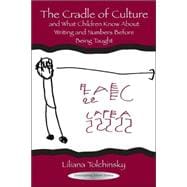
Note: Supplemental materials are not guaranteed with Rental or Used book purchases.
Purchase Benefits
Looking to rent a book? Rent The Cradle of Culture and What Children Know About Writing and Numbers Before Being [ISBN: 9780805838435] for the semester, quarter, and short term or search our site for other textbooks by Tolchinsky,Liliana. Renting a textbook can save you up to 90% from the cost of buying.
| Preface | xi | ||||
| Introduction What Children Know and We Have Already Forgotten About Writing and Numerals | xv | ||||
| Defining a Domain of Knowledge | xvii | ||||
| A Developmental Domain-Specific Perspective on Writing and Numerals | xxiii | ||||
| A Constructivist Perspective on Writing and Numerals | xxv | ||||
| Private and Public Aspects of Writing and Numbers | xxvii | ||||
| Literate Adults' Ideas About the Development of Writing | xxviii | ||||
| Outline of the Book | xxx | ||||
|
1 | (20) | |||
|
5 | (1) | |||
|
6 | (3) | |||
|
9 | (2) | |||
|
11 | (1) | |||
|
12 | (3) | |||
|
15 | (6) | |||
|
16 | (3) | |||
|
19 | (2) | |||
|
21 | (32) | |||
|
26 | (2) | |||
|
28 | (1) | |||
|
29 | (3) | |||
|
32 | (2) | |||
|
34 | (4) | |||
|
35 | (2) | |||
|
37 | (1) | |||
|
37 | (1) | |||
|
38 | (2) | |||
|
39 | (1) | |||
|
40 | (1) | |||
|
41 | (4) | |||
|
42 | (2) | |||
|
44 | (1) | |||
|
45 | (5) | |||
|
48 | (2) | |||
|
50 | (1) | |||
|
50 | (3) | |||
|
53 | (44) | |||
|
55 | (34) | |||
|
56 | (6) | |||
|
62 | (1) | |||
|
62 | (3) | |||
|
65 | (4) | |||
|
69 | (2) | |||
|
71 | (3) | |||
|
74 | (2) | |||
|
76 | (2) | |||
|
78 | (6) | |||
|
84 | (5) | |||
|
89 | (3) | |||
|
92 | (2) | |||
|
94 | (3) | |||
|
97 | (48) | |||
|
98 | (5) | |||
|
103 | (25) | |||
|
109 | (6) | |||
|
115 | (2) | |||
|
117 | (4) | |||
|
121 | (4) | |||
|
125 | (3) | |||
|
128 | (6) | |||
|
129 | (1) | |||
|
130 | (1) | |||
|
131 | (2) | |||
|
133 | (1) | |||
|
134 | (5) | |||
|
137 | (2) | |||
|
139 | (6) | |||
|
145 | (39) | |||
|
147 | (4) | |||
|
151 | (24) | |||
|
152 | (5) | |||
|
157 | (9) | |||
|
166 | (9) | |||
|
175 | (2) | |||
|
177 | (3) | |||
|
180 | (1) | |||
|
181 | (3) | |||
|
184 | (29) | |||
|
186 | (2) | |||
|
188 | (3) | |||
|
188 | (3) | |||
|
191 | (9) | |||
|
193 | (1) | |||
|
194 | (2) | |||
|
196 | (4) | |||
|
200 | (13) | |||
|
201 | (2) | |||
|
203 | (2) | |||
|
205 | (2) | |||
|
207 | (6) | |||
|
213 | (14) | |||
|
215 | (4) | |||
|
219 | (2) | |||
|
221 | (1) | |||
|
222 | (1) | |||
|
223 | (4) | |||
| References | 227 | (14) | |||
| Glossary | 241 | (6) | |||
| Author Index | 247 | (6) | |||
| Subject Index | 253 |
The New copy of this book will include any supplemental materials advertised. Please check the title of the book to determine if it should include any access cards, study guides, lab manuals, CDs, etc.
The Used, Rental and eBook copies of this book are not guaranteed to include any supplemental materials. Typically, only the book itself is included. This is true even if the title states it includes any access cards, study guides, lab manuals, CDs, etc.